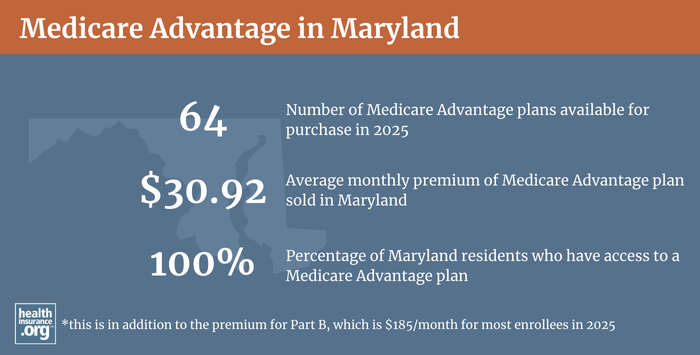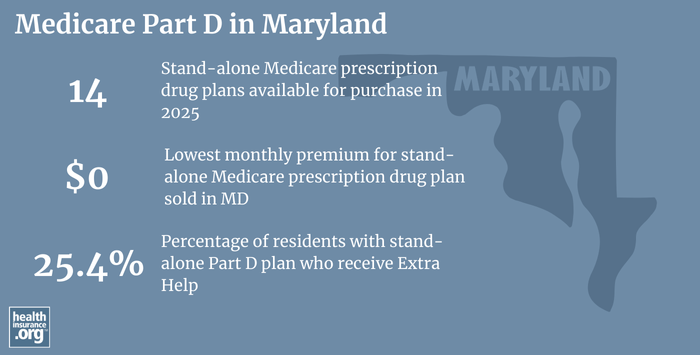Medicare in Maryland

More than 1.1 million people in Maryland have Medicare coverage; most are enrolled in Original Medicare.
Key Takeaways
- More than 1.1 million Maryland residents are enrolled in Medicare.1
- About 24% of Maryland Medicare beneficiaries select Medicare Advantage plans — far below the national average.1
- The availability of Medicare Advantage plans in Maryland depends on the county.
- There are 41 insurers offering Medigap plans in Maryland in 2025.2
- More than 550,000 Maryland Medicare beneficiaries were enrolled in stand-alone Part D prescription drug plans.1

Medicare enrollment in Maryland
The number of Maryland residents with Medicare stood at 1,145,093 as of August 2024,1 amounting to about 17% of the state’s population enrolled in Medicare.3
About 9% of Maryland’s Medicare beneficiaries are under 65 and eligible due to a disability that has lasted at least 24 months (people with ALS or end-stage renal disease do not have to wait 24 months for their Medicare coverage to take effect).1 The rest of the state’s Medicare beneficiaries — nearly 91% — are 65 or older and qualify for Medicare due to their age.1 Nationwide, about 89% of Medicare beneficiaries are at least 65 years old, while 11% are under 65 and eligible due to disability.4
Medicare options
Residents can choose how to access their Medicare benefits. The first choice is between Medicare Advantage plans, where coverage is through private Medicare Advantage plans, or Original Medicare, where services are paid directly by the federal government. Medicare beneficiaries also have options around Medigap policies and Medicare Part D (prescription drug) coverage.
Original Medicare includes Part A (also called hospital insurance, which helps pay for inpatient stays, like at a hospital, skilled nursing facility, or hospice center) and Part B (also called medical insurance, which helps pay for outpatient care like a doctor appointment or a preventive healthcare service, such as most vaccinations). Medicare Advantage plans bundle Parts A and B under a single monthly premium and often include other services like prescription drug and vision coverage. There are pros and cons to either option, and the “right” solution is different for each individual.
Learn about Medicare plan options in Maryland by contacting a licensed agent.



Explore our other comprehensive guides to coverage in Maryland

We’ve created this guide to help you understand the Maryland health insurance options available to you and your family, and to help you select the coverage that will best fit your needs and budget.


Hoping to improve your smile? Dental insurance may be a smart addition to your health coverage. Our guide explores dental coverage options in Maryland.


Learn about Maryland’s Medicaid expansion, the state’s Medicaid enrollment and Medicaid eligibility.


Short-term health plans provide temporary health insurance for consumers who may find themselves without comprehensive coverage. Learn more about short-term plan availability in Maryland.

Frequently asked questions about Medicare in Maryland
What is Medicare Advantage?
Nationwide, about a third of all Medicare beneficiaries were enrolled in private Medicare Advantage plans as of 2018. But in Maryland, just 11% of Medicare beneficiaries selected Medicare Advantage plans. Most of the rest were covered under Original Medicare, but there are also some Maryland Medicare beneficiaries with Medicare Cost plan coverage.
By August 2024, about 19% of people with Medicare in Maryland were enrolled in private plans (mostly Medicare Advantage plans, but also some Medicare Cost plans), while the other 81% were enrolled in Original Medicare.1 At that point, total private plan enrollment among Medicare beneficiaries nationwide had grown to about 50%,4 but Medicare Advantage enrollment continues to be less popular in Maryland.
The availability of Medicare Advantage plans in Maryland varies from one county to another. In St. Mary’s County, there are only 3 Medicare Advantage plans available in 2024. But there are 26 plans available in Baltimore County.5
Medicare beneficiaries can switch back and forth from Medicare Advantage to Original Medicare or vice versa each fall during the annual open enrollment period (October 15 through December 7). There is also a Medicare Advantage open enrollment period (January 1 to March 31) during which people who are already enrolled in Medicare Advantage plans can change to a different Medicare Advantage plan or drop their Medicare Advantage plan and enroll in Original Medicare instead.

What are Medigap plans?
Medigap plans are used to supplement Original Medicare, covering some or all of the out-of-pocket costs (for coinsurance and deductibles) that people would otherwise incur if they only had Original Medicare on its own.
Medigap plans are standardized under federal rules, with ten different plan options available. In Maryland in 2025, there are 41 insurers providing Medigap plans, although some only offer a few of the ten plan designs.2
Under federal rules, Medicare beneficiaries have a six-month window, when they are at least 65 and first enrolled in Medicare Part B, during which coverage is guaranteed issue for Medigap plans. Maryland has gone a step further than that and joined several other states that offer “birthday rules” that allow Medigap enrollees to switch to a different plan, without medical underwriting, during an annual window around their birthday. In Maryland, the birthday rule took effect in mid-2023. It allows a person with Medigap to switch to a different Medigap plan — with equal or lesser benefits — during a 30-day window that starts on their birthday each year.
Federal rules do guarantee access to a Medigap plan if you’re under 65 and eligible for Medicare as a result of a disability.
But Maryland is among the majority of the states that ensure at least some access to Medigap plans for enrollees under the age of 65. In Maryland, Medigap insurers are required to offer Plan A to enrollees who are under 65, on a guaranteed-issue basis if the person applies for the Medigap plan within six months of enrolling in Medicare Part B (insurers are also required to offer Medigap Plan D to beneficiaries, but only if the insurer offers that plan to other enrollees; insurers that offer Medigap Plan C must also offer it to disabled Medigap enrollees who were already eligible for Medicare prior to 2020; under federal rules, Medigap plans C and F cannot be sold to anyone who is newly eligible for Medicare in 2020 or later). The requirement that Medigap insurers offer coverage to disabled beneficiaries is a result of Maryland S.B.48, which took effect in 2017.
The premiums are higher for enrollees under age 65, although they are given another enrollment window when they turn 65, so they can then change to lower-cost Medigap coverage at that point, or pick a plan other than Plan A or C/D. And Maryland does limit the pricing on Medigap Plan A for disabled enrollees: It cannot exceed the average of the premiums paid for that Plan A by enrollees who are 65 and older.
What is Medicare Part D?
Original Medicare does not cover outpatient prescription drugs. But Medicare beneficiaries can get prescription coverage via Medicaid (if they’re qualified by low income and assets), a Medicare Advantage plan, an employer-sponsored plan (offered by a current or former employer), or a stand-alone Part D prescription plan.
For 2025 coverage, insurers are offering 14 stand-alone Part D plans available in Maryland, with premiums starting at $0 per month.6
566,157 Maryland Medicare beneficiaries were enrolled in stand-alone Part D prescription drug plans (PDPs) in Maryland as of August 2024.1 Despite the fact that overall Medicare enrollment has grown, that was a little lower than the state’s PDP enrollment had been a year earlier, due to the growth in Medicare Advantage enrollment.
Most Medicare Advantage plans include Part D prescription drug coverage, so stand-alone Part D plans are almost always used to supplement Original Medicare. Enrollment in Original Medicare in Maryland is higher than average, which is why stand-alone Medicare Part D enrollment in Maryland is also higher than average. In addition to the people with stand-alone Part D coverage, 251,905 Medicare beneficiaries in Maryland have Part D benefits as part of their Medicare Advantage coverage.1

How does Medicaid provide financial assistance to Medicare beneficiaries in Maryland?
Many Medicare beneficiaries receive financial assistance through Medicaid with the cost of Medicare premiums, prescription drug expenses, and services Medicare doesn’t cover – such as long-term care.
Our guide to financial assistance for Medicare enrollees in Maryland includes overviews of these benefits, including Medicare Savings Programs, long-term care coverage, and eligibility guidelines for assistance.
What additional resources are available for Medicare beneficiaries and their caregivers in Maryland?
If you need help with your Medicare application in Maryland or have general questions about Medicare eligibility in Maryland, try one of these resources for assistance.
- Maryland Senior Health Insurance Program: Visit the website or call your county office.
- The Maryland Insurance Administration has a comprehensive overview of Medigap in Maryland, and a detailed comparison of how Medigap premiums vary by age and insurer in Maryland.
- Visit the Medicare Rights Center. This website provides helpful information geared to Medicare beneficiaries, caregivers, and professionals.
Louise Norris is an individual health insurance broker who has been writing about health insurance and health reform since 2006. She has written dozens of opinions and educational pieces about the Affordable Care Act for healthinsurance.org.

Looking for more information about other options in your state?
Need help navigating health insurance options in Maryland?
Explore more resources for options in Maryland including ACA coverage, short-term health insurance, dental insurance and Medicaid.
Speak to a sales agent at a licensed insurance agency.
Footnotes
- “Medicare Monthly Enrollment – Maryland.” Centers for Medicare & Medicaid Services Data. Accessed December, 2024. ⤶ ⤶ ⤶ ⤶ ⤶ ⤶ ⤶ ⤶ ⤶
- “Explore your Medicare coverage options.” Medicare.gov. Accessed October, 2024. ⤶ ⤶
- U.S. Census Bureau Quick Facts: United States & Maryland.” U.S. Census Bureau, July 2023. ⤶
- “Medicare Monthly Enrollment – US” Centers for Medicare & Medicaid Services Data, November 2024. ⤶ ⤶
- ”Medicare Advantage 2024 Spotlight: First Look” KFF.org Nov. 15, 2023 ⤶
- ”Fact Sheet: Medicare Open Enrollment for 2025” (62) Centers for Medicare & Medicaid Services. Sep. 27, 2024 ⤶

